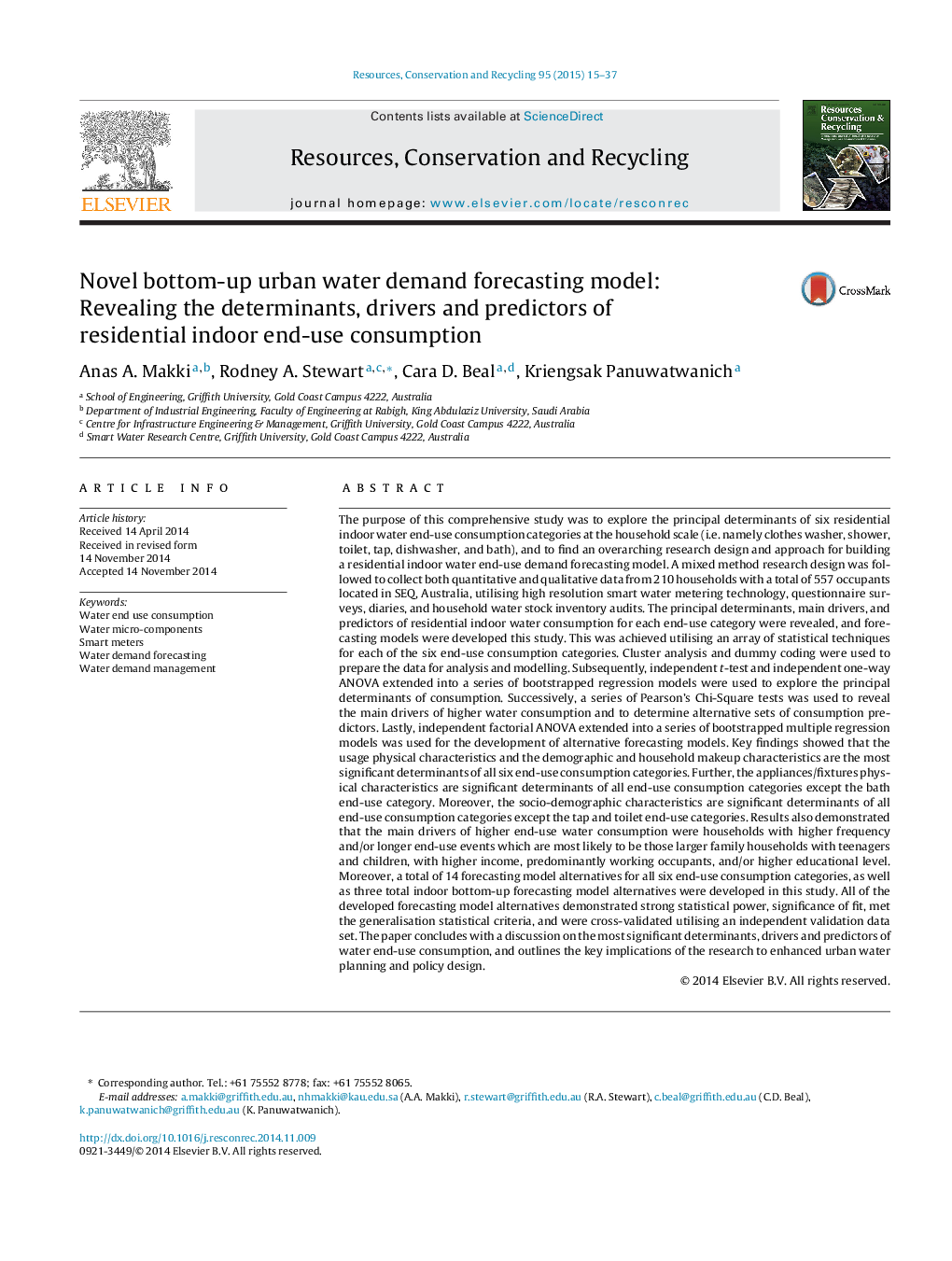| کد مقاله | کد نشریه | سال انتشار | مقاله انگلیسی | نسخه تمام متن |
|---|---|---|---|---|
| 7495175 | 1485694 | 2015 | 23 صفحه PDF | دانلود رایگان |
عنوان انگلیسی مقاله ISI
Novel bottom-up urban water demand forecasting model: Revealing the determinants, drivers and predictors of residential indoor end-use consumption
ترجمه فارسی عنوان
مدل پیش بینی تقاضای آب شهری از پایین به بالا رونق: تعیین عوامل تعیین کننده، رانندگان و پیش بینی کننده مصرف برق پایینی مسکونی
دانلود مقاله + سفارش ترجمه
دانلود مقاله ISI انگلیسی
رایگان برای ایرانیان
کلمات کلیدی
مصرف آب پایان مصرف، میکروموتورهای آب متر هوشمند، پیش بینی تقاضای آب، مدیریت تقاضای آب،
موضوعات مرتبط
مهندسی و علوم پایه
مهندسی انرژی
انرژی های تجدید پذیر، توسعه پایدار و محیط زیست
چکیده انگلیسی
The purpose of this comprehensive study was to explore the principal determinants of six residential indoor water end-use consumption categories at the household scale (i.e. namely clothes washer, shower, toilet, tap, dishwasher, and bath), and to find an overarching research design and approach for building a residential indoor water end-use demand forecasting model. A mixed method research design was followed to collect both quantitative and qualitative data from 210 households with a total of 557 occupants located in SEQ, Australia, utilising high resolution smart water metering technology, questionnaire surveys, diaries, and household water stock inventory audits. The principal determinants, main drivers, and predictors of residential indoor water consumption for each end-use category were revealed, and forecasting models were developed this study. This was achieved utilising an array of statistical techniques for each of the six end-use consumption categories. Cluster analysis and dummy coding were used to prepare the data for analysis and modelling. Subsequently, independent t-test and independent one-way ANOVA extended into a series of bootstrapped regression models were used to explore the principal determinants of consumption. Successively, a series of Pearson's Chi-Square tests was used to reveal the main drivers of higher water consumption and to determine alternative sets of consumption predictors. Lastly, independent factorial ANOVA extended into a series of bootstrapped multiple regression models was used for the development of alternative forecasting models. Key findings showed that the usage physical characteristics and the demographic and household makeup characteristics are the most significant determinants of all six end-use consumption categories. Further, the appliances/fixtures physical characteristics are significant determinants of all end-use consumption categories except the bath end-use category. Moreover, the socio-demographic characteristics are significant determinants of all end-use consumption categories except the tap and toilet end-use categories. Results also demonstrated that the main drivers of higher end-use water consumption were households with higher frequency and/or longer end-use events which are most likely to be those larger family households with teenagers and children, with higher income, predominantly working occupants, and/or higher educational level. Moreover, a total of 14 forecasting model alternatives for all six end-use consumption categories, as well as three total indoor bottom-up forecasting model alternatives were developed in this study. All of the developed forecasting model alternatives demonstrated strong statistical power, significance of fit, met the generalisation statistical criteria, and were cross-validated utilising an independent validation data set. The paper concludes with a discussion on the most significant determinants, drivers and predictors of water end-use consumption, and outlines the key implications of the research to enhanced urban water planning and policy design.
ناشر
Database: Elsevier - ScienceDirect (ساینس دایرکت)
Journal: Resources, Conservation and Recycling - Volume 95, February 2015, Pages 15-37
Journal: Resources, Conservation and Recycling - Volume 95, February 2015, Pages 15-37
نویسندگان
Anas A. Makki, Rodney A. Stewart, Cara D. Beal, Kriengsak Panuwatwanich,
